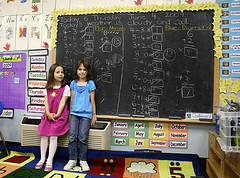Math for Grownups blog readers tend to fall into two camps: grownups who are not parents and really hate math (or think they’re not good at it), and parents who are worried that they’re going to pass along their math anxiety to their kids. And so I thought I’d spend a little bit of time addressing some of the concerns of these parents.
Earlier this week, my friend and fellow freelancer, Debbie Abrams Kaplan forwarded the summary of a new bit of research on kids and math. Debbie is the author of two great blogs: Jersey Kids and Frisco Kids, and she figured that I might find some blog fodder from this study.
Boy did I! A couple of things jumped out at me:
- No one has ever studied how the basic math skills of first graders affect their later understanding of math throughout elementary school. (Compare that with the many studies of early reading skills, and this fact will blow your mind, too.)
- There are three basic skills that will help first graders become good fifth-grade math students.
I’m going to tell you those skills a little later, but first I want to introduce the concept of numeracy. Quite simply, numeracy is the ability to work with and understand numbers. When children are young, numeracy includes the ability to count, recognize the symbols that we use for numbers (which is akin to learning the alphabet), and even do some very simple operations (like 1 + 1 = 2). For high school students, numeracy includes more complex problem solving skills and properties of real numbers.Among math educators, there are big debates about how we can better teach numeracy. I guess this is like the debates about phonics vs. context support methods in reading education. But now that this study is out, it’s clear parents can help lay a firm foundation for our kids’ later success in math. According to this study, published by a team of University of Missouri psychologists, rising first graders should understand:
- Numbers — I’m going to take this to mean whole numbers, since most first graders aren’t very familiar with fractions or decimals.
- The quantities that these numbers represent — In other words, kids should be able to match a number with that same number of objects (five fingers, two cats, etc.)
- Low-level arithmetic — And I’m guessing researchers mean things like adding and subtracting numbers that are smaller than 10 (excepting problems with negative answers).
If you’re like most parents, this is probably a duh moment. What’s so hard about recognizing whole numbers or understanding what five objects are? But I don’t think many parents spend much time emphasizing these ideas — at least not in the way that we commit to reading to our children every night.So here are a few ways that you can help instill numeracy in your pre- or elementary-school aged children.
- Count things. Count everything — like the stairs that your climbing or the cars that pass your house or blocks as you take them out of the box or those adorable little toes!
- Have your child count things. You can do this in really simple ways. Ask him to get you five spoons so you can set the table. When she wants some goldfish, tell her she can have 10 (and watch her count them). When you’re planning his birthday party, have him tell you which 10 friends he wants to invite. (Write them down for him, so he has something visual to count.)
- Notice numbers. When she’s really tiny, ask her to say the numbers that are on your mailbox or on a license plate. Older kids can name multi-digit numbers, like 157 or 81. (And if you want to really be precise and prep your kid for school, don’t say things like “one hundred and fifty-seven. In math, “and” represents a decimal point, which is something most elementary school teachers will really drive home.)
- Teach your child to count backwards. This can be a great way for kids to start understanding subtraction. If you know you have 10 steps in your staircase, count backwards as you go down the stairs. Then count frontwards as you go up!
- Start adding and subtracting. Give your child 5 raisins and show her how to “count up” to 7 by adding 2 raisins to the pile. Then as your child eats the raisins one by one, “count down” to find out how many are left.
You don’t need to make a big deal about math. And for goodness sakes, skip the worksheets, flashcards and even video games — unless your kid really loves them. Integrate these basic skills into your daily life, and you’ll see your child’s understanding grow. (And you probably won’t feel so stressed out about it all!)What kinds of things do you do with your young elementary-age kids? Any teachers out there want to share their thoughts with the class? Post in the comments section.



